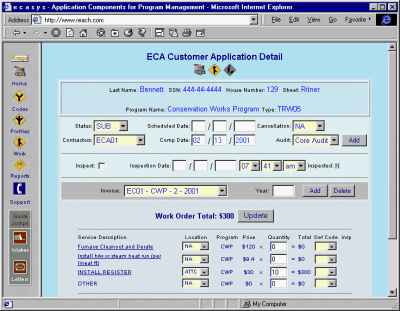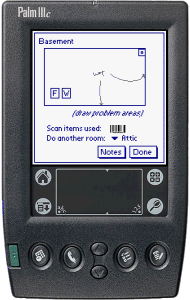The Joy of a Well-Designed Software Program
 |
by Liz Robinson and Bill Shadish
"For the first time in sixteen years,
we now know exactly
what we |
An agency that helps low-income people keep
the heat on goes high-tech in delivering services to its clients.

Low-income people receiving energy and water assistance in Philadelphia are benefiting from a computer software program designed to meet their needs.
As the nation moves toward another winter with energy prices still high, organizations that help low-income people in cold regions to keep the heat on will probably be inundated with requests for help. How well these organizations handle their clients' information can have serious consequences for the clients.
We at the Energy Coordinating Agency of Philadelphia
(ECA)--a private, nonprofit corporation dedicated to ensuring
that low- and moderate-income people have access to safe, affordable,
and reliable sources of energy and water-have recently made great
strides in how well we handle our clients' needs, thanks to a
new software package we've adopted. Tailored to fit, the software
package addresses a wide variety of energy program needs, and
its framework is easy to extend to meet future needs.
Our new software package had its roots in the
looming Y2K software crisis we faced in the spring of 1999. At
the time, we were using a wide variety of software packages and
tools throughout our various departments to handle our day-to-day
tasks. We used Access 2.0 (circa 1994), Excel macros, Quattro
Pro, and lots of slips of paper to keep track of our clients,
contractors, and work orders. You can imagine the administrative
nightmares that this posed, but it also made it impossible to
provide comprehensive service to our customers. We couldn't easily
tell if a customer had been serviced in more than one energy program,
since the software supporting each program did not talk to the
software supporting any of the others.
We also had a structure through which contractors
were assigned tasks to do in the field, which they recorded on
paper. These handwritten notes were sent to our central office,
where they were keyed into database applications and sometimes
keyed again into other systems. This resulted in staffing inefficiency
and an increased chance of keying errors on any given task.
Y2K to the Rescue
We struggled along with this structure until the Y2K crisis forced us to consider alternatives. (The possibility of being without any functioning software did not seem like very much fun.) We engaged a software consulting firm, Fundamental Objects, Incorporated, to create one database to support all of our needs and to handle the Y2K issues we faced.
The company began, not by diving in to create software, but rather by striving to understand our process. From here, we jointly created a software system that not only handled our current needs, but also was structured to anticipate future ones.
Flexibility Promotes Ease
The ecasys application that evolved from this process features a Web-based relational database to hold our data. The database allows for the coordination of a number of services and programs, and it is structured in such a way that it can be very easily extended if necessary. We have found that it provides a good deal of flexibility. For example, we initially wanted to run 7 energy programs using ecasys. We have been able to extend the application to run 23 different programs without having to make any additional programming changes. The reason that it is easy to add things is that everything is very generalized. Our Water program, Low Income Heating Assistance program, and Weatherization Assistance program all share the same basic internal structure within ecasys. This means that any report, query, or price that we want to work with acts the same for any or all of the energy programs that we want to manage. It is just that easy to do.
Given the confidential nature of the data surrounding
our clients, security was a big concern for us. The database application
has four levels of security:
- Windows challenge/response, which controls who can log in;
- User/group-based roles, which allows us to group functionality together and to determine who then has access to the functional grouping;
- Administrative, which is a completely different level of access to the system; and
- Internet firewall security, which controls what machines have physical access to our network.
All in all, we feel fairly safe placing our data within this system.
The ecasys software uses Internet Explorer
to present information to our users, who include ECA staff, outside
agencies who support our programs, and utilities who provide some
of our funding. The interface is icon driven, using road
sign symbols. It is easy to navigate from one spot to another,
since there are several ways to get from place to place with only
a click or two of the mouse.

the specific information that they need, using the same Internet portal.
Everything from scheduling customer visits to work order and inspection dates is now available in one place, using month-at-a-time online calendars. The system is very profile oriented, which means that we can easily change or add new definitions, contractors, customers, programs, and services, as well as prices.
Possibly the most important aspect of this application is the fact that it is truly a relational database system. For the first time in sixteen years, we now know exactly what we are doing for a customer, across all programs, provided the paper forms are filled out properly and the data are entered properly. We administer a citywide network of Neighborhood Energy Centers, each of which uses ecasys to record all of their energy services. Not only can we now track and monitor our work accurately in every program, but we can monitor how well we are accomplishing our goal of providing comprehensive energy services- across programs and across providers.
The most heavily used features, such as our
customer intake process, are displayed separately as "Quick
Jumps" in the bottom left of the main screen. From here you
can e-mail anyone, which saves us moving between software applications
in order to do our simple everyday tasks.
Handhelds
There are Palm-pilot extensions to ecasys
coming, such as the Work Order application shown in the photo.
Our contractors can take electronic information about a customer
right into the customer's home, without having to use a very visible
and expensive laptop. They can enter information about specific
services that need to be applied within the home, order items
to install, draw quick sketches of problem areas, and even take
customer signatures for work performed. The biggest advantage
here is a further reduction in rekeying. In the past, the same
information on any given work order had to be rekeyed up to three
times. Now it doesn't have to be rekeyed at all.

safety concerns and needed energy in a very efficient and low-profile way.
The next growth area for us will be to perform on-site audits using the Palm-pilot. Having wireless auditing tools will compress the current cycle of contractor work, inspection, punch list, and reinspection and will further increase our efficiencies so that we can focus on our true area of interest-increasing access to affordable energy for those who need it most.
Liz Robinson is executive director of the Energy Coordinating Agency of Philadelphia, in Philadelphia, Pennsylvania. Bill Shadish is principal of Fundamental Objects, Inc., in Downington, Pennsylvania.
For more information:
On program management issues, contact:
Liz Robinson
Energy Coordinating Agency of
Philadelphia, Incorporated
1924 Arch St.
Philadelphia, PA 19103
Tel: (215) 988-0929, Ext. 233
Fax: (215) 988-0919
Web site: http://www.ecasavesenergy.org
On technical features of ecasys,
contact:
Bill Shadish
Fundamental Objects, Inc.
Downingtown, PA 19335
Tel: (610) 873-8022
Web site: foaudits.com
For more information about ecasys, including
demos, overviews, on-line presentations, and feature descriptions,
go to http://www.FundamentalEnergy.com.